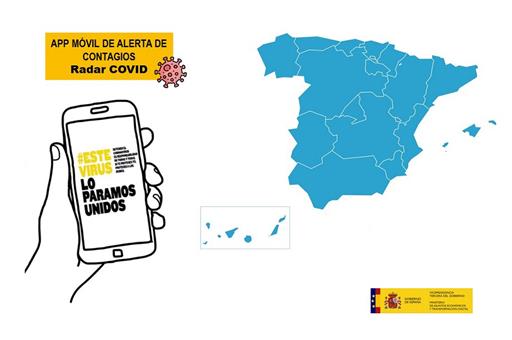RadarCOVID - the contagion alert app for mobiles - has passed the test phase satisfactorily and is now available to the health authorities of the regional governments.
This was explained by the State Secretary for Digitalisation and Artificial Intelligence, Carme Artigas, at a press conference at which she shared the results obtained in the pilot project. She was accompanied by Pilar Aparicio, Director-General of Public Health and Innovation of the Ministry of Health, Pablo Hernández, Director-General of Modernisation and Quality of the Services of the Regional Government of the Canary Islands, Santiago Graña, Assistant Director-General to Drive Digitalisation of the Public Authorities, and Pablo Rodríguez, technical advisor of the project.
Success in terms of adoption, commitment, retention and functioning
The pilot project was approved at the Council of Ministers on 23 June, and began on 29 June and implemented until 31 July, during which time four fictitious spikes of COVID-19 were simulated. In this period, and despite it only operating on the island of La Gomera, more than 60,000 people downloaded the app throughout Spain.
The first aim of the pilot project consisted of evaluating the adoption of the tool, that is, the number of people who downloaded it, and a goal was set of 3,000 participants on La Gomera, which was easily obtained according to the figures during the test phase.
A second goal consisted of measuring the retention, in relation to the number of users that maintained the app active after having downloaded it. The results, which were also satisfactory, pointed to an average retention of 83%.
In addition, the commitment was analysed of users in communication of fictitious positive cases, achieving a level of 61% of active communications, of which 78% took place in the 24 hours following the reception of the simulated contagion code.
Another of the goals sought in the pilot project was to measure the functioning of the app when tracing contacts, with an average of 6.4 close contacts of risk detected by confirmed simulated positive. This figure almost doubles the current efficacy of manual tracers, which detected an average of 3.5 contacts in the Canary Islands.
Favourable reviews from users
Through interviews and questionnaires, the opinions of users have also been obtained regarding their user experience. All the questionnaires show that they will continue using the app when activated at a national level, and almost all (82%) rate it as a useful tool in the prevention of the spread of COVID-19. The general assessment of the tool posted a score in the questionnaires of 8.2 out of 10.
By category, the highest ratings corresponded to the willingness of users to recommend the app in their social circles (9.2 out of 10), easiness of use (8.6), comprehension of the instructions (8.7) and the sensation of privacy and anonymity (8.6).
Next steps and deadlines
Once the approval was obtained from the health authorities, the next step was to make this app available to the regional governments, which the President of the Government did last Friday at the 21st Conference of Regional Presidents. Those regional authorities that so wish can connect the tool to their health alert management systems.
Given the current situation of the emergence of some spikes of localised contagion in certain regions after recovering mobility, an initial functional version of the tool may become available to be specifically implemented in mid-August.
The rollout in the rest of the country, in the event that the regional authorities decide to adopt this in the exercise of their powers, will take place in September.
Functioning of the app
RadarCOVID follows the technical standards that guarantee privacy for users in compliance with the recommendations drawn up by the European Commission to this end. Accordingly, no user may be identified or localised because no data are recorded and because the process is carried out on their telephone without resorting to any server. Both the use of the app and the communication of any potential contagion are always voluntary.
The application uses Bluetooth connections to the device, through which mobile phones emit and observe anonymous identifiers from other phones that periodically change. When two devices have been in close proximity for 15 minutes or more, at a distance of two metres or less, both save the anonymous identifier emitted by the other device.
If any user is diagnosed as positive for COVID-19 after performing a PCR test, they can decide whether to give their consent so that, through the heath system, an anonymous notification can be sent. Accordingly, mobile phones that have been in touch with a patient will receive a warning on the risk of potential contagion and instructions will be provided on how to proceed. Since no data are requested, it is impossible to identify or localise any user.
At present, the European Commission is developing a legal and technical framework to make interoperability possible between applications based on a decentralised model, as in the case of RadarCOVID, so that this can continue to function beyond the borders of any State. The Government of Spain has advocated an interoperable model from the outset to enhance the scope of this type of tool.
Non official translation





